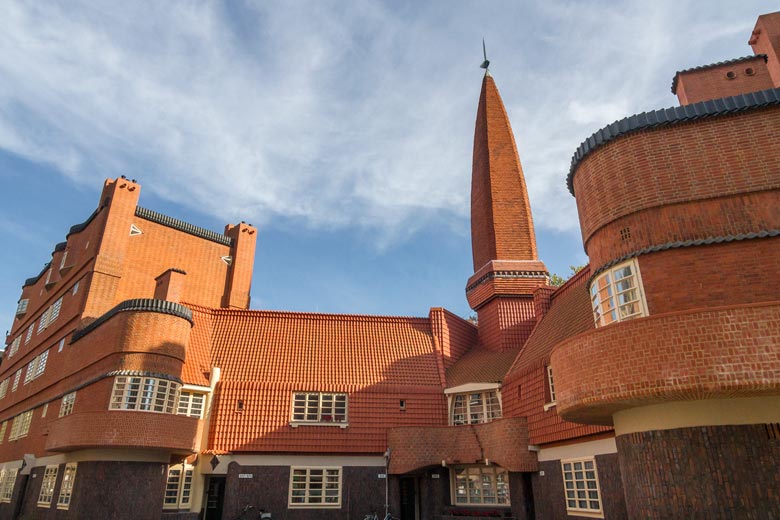Art critic J. Williams wrote a beautiful text on workers' palace Het Schip. Read his words below:
Het Schip: material for dreaming
Hop on board Het Schip (The Ship)! Like a red bricked modern ark with its fantastic beasts within, the nautical building crosses the foam of dreams. You can feel, once inside, the delicate feeling of mysticism, surrounded by all those ethereal forms and shapes reminding the visitor- passenger of the sensible world, or not.
Conceived as a “workers’ palace” in the 1920s, designed by Michel de Klerk, this is one of the purest architectural examples of the Amsterdam School’s style (1915-1930), that group of young architects, from which the most famous remains de Klerk, which inspired much of the city’s landscape we know nowadays.
The place overcomes by far its original housing function: it is a temple on a pagoda where architecture is thought as a gay science, where the inventor allied to the craftsman is calling for utopia. The space would be better defined as a global substance in which every object or line espouses a particular meaning, a hymn to the small details finally creating the masterpiece.
It is here more about being an artist rather than a simple scientist specialized in architecture, something clearly demonstrated by the visual principles of the Amsterdam School throughout its active period. A subjective doctrine is then retained over the H.P. Berlage’s objective method (zakelijke), which inspired during the same years the opposed group De Stijl favoring a total uniform standing of the building.
What an intellectual rivalry it must have been between those two groups! Both regularly mandated by the city of Amsterdam for designs and constructions with so many differences! Does the architect must be considered a kind of prophet? On the contrary, does he or she have to limit themselves to their task? Open your eyes! Our urban reality around us spreads here and there the defeats and victories of the two movements – of this past emulation. What is sure though is that the Amsterdam School conquered Het Schip. The whole individuality of the construction characterizes the building. The communal art it is reflecting has historically been offered to a community made of diverse people sharing a similar working condition.
We know that Eigen Haard, the cooperative housing association which initiated the construction of The Ship and which commissioned de Klerk to design it, was a socialist organization. Nevertheless, strolling in and out the building invites to think of other broader and transcendental inspiring sources than only political ones.
It is a temple on a pagoda – there, the socialist obedience of the building would logically require to write: it is an atheist temple on a pagoda. Anyway, the forms are spiritually expressive. The well-known tower which culminates above the whole is not a church’s spire, but rather recalls Java or Bali – far away from the post-colonial Netherlands.
The Amsterdam School had contacts with the colonial world of the time and what was then the Dutch Indies – de Klerk met few indigenous anti-colonial thinkers in Belgium. The group knew the particularities of the Minangkabaus (an ethnic group in West-Sumatra) and Bataks (an ethnic group in North-Sumatra) architectures: the Minangkabau’s house and the Toba Batak’s house have notably inspired the group for their works in Mokum.
An example of that heritage is the spectacular tower of Het Schip which sort of reminds of the Borobudur’s style, that massive Buddhist temple erected in Java representing dozens of Buddhas seating in stupas – or the corolla of a lotus?
Yet does the inspiration of the building is not going further than this alone, which after all is attached to the sensible world and its different cultures?
This is surely not possible to define a clear source that would have entirely inspired the construction! It is there necessary to rely on one’s own sensation and look to maybe feel – through those curbs and furniture – the revelation of something sacred?
Does that mystic refer to the Theosophical Society very active in the Netherlands during that period? We remember indeed that Johannes Lauweriks, another prominent figure of the Amsterdam School, was involved in it – and that more generally, the thesis developed by that movement were appealing to a common greater future (notably an idea about numerology, where numbers had particular significance) intellectually very “in vogue” at the beginning of the 20th century…
We could also suppose that those mysterious lines are to be related to the widely publicized discoveries made about the animal world at the end of the 19th century!
Is it perhaps a mix of all that?
Anyhow, the utopian ideas regain some strength! A new imaginary proper to the emerging West-European mass societies was then very active, fruitful in ideals and hopes. The Ship is a superb witness of that moment.
Eventually, it is a kind of immemorial aspect of things where the continuity of the ages is celebrated: the structure adopts its own form even its independence. The rhythm injected by de Klerk makes the building waving on its bricked hull – the materials are alive, and Het Schip leaves its shores.
J. Williams is the pseudonym of Benjamin Hagiarian.




